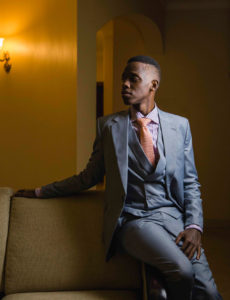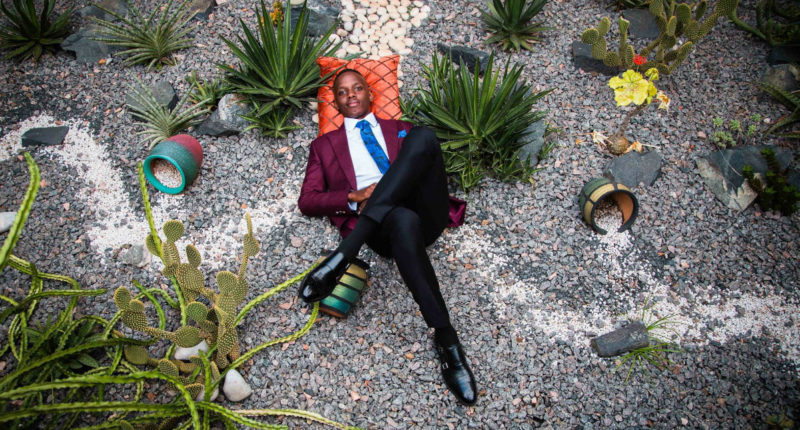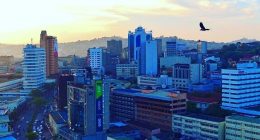More often than not, outward appearances tell of one’s character. A man in a well-tailored suit exudes pride, a sense of self-worth and sophistication.
In Uganda, the locally made suits are everywhere, especially in Kiyembe in the Kampala city centre. St. Balikuddembe, formerly Owino, market also provides a host of suppliers for both made-to-fit suits and imported second hand designer suits at affordable prices.
Most high end suits are either imported or can be found in high end shops at quite high prices. But there is a game changer in town; Little Red Curious of Exousia, who offer custom-made suits for as low as Shs200,000.
The man behind the Little Red Curious brand is Martin Bakeine. This exceptionally talented young tailor is the co-founder of Exousia House of Fashion based in Kampala.
When we sit down for an interview with Martin at a takeaway joint in Kampala’s surburb of Ntinda, I realize Martin’s style is relaxed and casual. He is friendly, down to earth and has a disarming charm.
Who is Martin Bakeine?

He is now a third year finalist of International Business at Makerere University Business School (MUBS).
This young tailor is one of Uganda’s youth creating gainful employment amidst soaring numbers of youth unemployment.
This entrepreneurship trait seems to run in the family blood. Bakeine says his father set up one of the first tour and travel companies in the country.
So why custom made-to-measure suits? “My co-partners and I, Nivan and Eugenia, chose to exploit the gap from the mainstream industry which doesn’t give consumers much choice.” Exousia’s portfolio is not limited to custom made suits but they also venture into children, ladies and men’s wear. “My team at Exousia also offers styling services,” adds Martin.
To distinguish his role, Martin defines a designer as one who comes up with new couture concepts whereas a stylist merely re-invents the whole imaginative ideal fashion look.
TIT BITS
Source of inspiration
“I love my job because it gives me purpose, supplies my needs and allows me to provide a service. I look up to Lamic Kirabo of Third Local. She is a leading fashion blogger.” Martin also looks up to the Rwanda-based House of Tayo label, founded by Matthew Rugamba.
Achievements
“Engaging my entrepreneurial skills to self-employment as a youth has been a key milestone for me and the co-founders I work with. As a team, we have managed to style key personalities; I also showcased at my first runway last month at the MUBS Annual Awards and Incentives portfolio 2017. I was honoured to showcase along Sylvia Owori, a fashion icon in the industry.”
Challenges
“Market penetration is still a challenge despite the free East African market protocol that was passed. People still have stereotypes towards the quality of locally-made suits because they only know what they know and don’t know much about what we are doing.
“The biggest challenge is the access to information about my service by clients. Social media marketing has, however, been able to help us get through to the youth.
“We don’t have a permanent establishment yet but I have faith that at the end of this year, our brand will have grown and become well established.
“I anticipate that this business should be sustainable. I want to penetrate the EAC regional markets so we can create a bigger, better and bolder brand.
“Government initiatives that could support the textile industry include setting up special trade zones and favourable tax treatment for exports to boost fashion entrepreneurship.”
Textile industry prospects
The Swedish Trade and Invest Council 2014 Report Indicated how East African countries can source for attractive opportunities in the Textile and garments industry.
If adopted, these could spur the collective GDP growth which had been estimated by the World Bank to be USD 218 billion (2014). This follows recent developments in policy and trade agreements that have made textiles and apparels the most interesting trade segment especially in Ethiopia, Kenya and Tanzania.
Fashion entrepreneurs such as Martin Bakeine embody the growing manufacturing sector in East Africa which presents unique investment opportunities as observed in the AFDB EARC report of 2014.
Government intervention and changing macro-economic trends are making textile sourcing in East Africa appealing. Proximity sourcing is becoming an important consideration for both European and US textile and apparel companies. Africa is considerably closer to Europe and US than the Asian countries.
The US African Growth and Opportunity Act (AGOA), provides 39 African countries with duty-free access to the US markets. Textiles and apparel have been the primary source of job and income creation through AGOA exports. Which is why this could solve youth unemployment.









